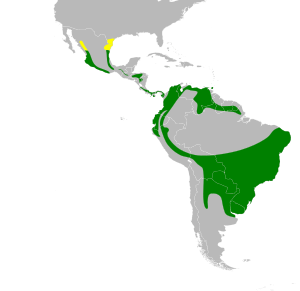Tropical parula facts for kids
Quick facts for kids Tropical parula |
|
|---|---|
 |
|
| In Brazil | |
| Conservation status | |
| Scientific classification | |
 |
|
| Range of S. pitiayumi Breeding range Year-round range | |
| Synonyms | |
|
Setophaga americana pitiayumi |
The tropical parula (Setophaga pitiayumi) is a small, colorful bird. It's a type of New World warbler. These birds live in many places. They breed from southern Texas and northwest Mexico. Their home stretches all the way south to northern Argentina, including Trinidad and Tobago. You can find them in many areas. Because of this, the IUCN says they are not in danger.
This bird is a passerine, which means it's a perching bird. Tropical parulas usually do not migrate long distances. However, birds from northern areas might move around locally. For example, they don't breed in much of Pacific Central America. But you can still see them there sometimes, like in El Salvador.
Contents
What Does a Tropical Parula Look Like?
This bird is about 4.3 inches (11 cm) long. Its upper body is mostly blue-grey. It has a greenish patch on its back. You can also see two white bars on its wings. Its belly is yellow, and its chest is orange.
How to Tell Males and Females Apart
Male tropical parulas have a black patch. This patch goes from their beak to behind their eye. Female birds look a bit duller than males. They do not have the black patch on their head. Young tropical parulas are not as brightly colored. They also do not have the wing bars. Instead, they have a grey band on their chest.
What Does a Tropical Parula Sound Like?
The song of the tropical parula is a high, buzzing sound. It sounds like a trill. Their call is a short, sharp tsit.
Different Types of Tropical Parulas
There are about 14 different types, or subspecies, of the tropical parula. They can have slightly different colors. One type, S. p. graysoni, lives only on Socorro Island. This island is part of the Revillagigedo Islands. Sometimes, some of these types are thought to be separate species. This is especially true for those living on islands.
The tropical parula is very similar to the northern parula (S. americana). Sometimes, they are even considered the same species. You can find mixed birds, called hybrids, in the Lower Rio Grande Valley of southern Texas. This might be a new thing. Most tropical parulas do not have white crescents around their eyes. This helps tell them apart from northern parulas. But in hybrids, it can be hard to tell. You should also look at how much yellow is on their chest and belly.
In 2005, a female tropical parula was seen in Ecuador. It had some white spots on its forehead and around its eyes. This made it look like a hybrid. But hybrids would usually only be found as far south as Panama.
Where Do Tropical Parulas Live?

Tropical parulas mostly live in forests on hills and mountains. They do not live in the Amazon basin. They seem to like forests that have been slightly changed. They also do well in areas where forests are broken up into smaller pieces. For example, on the eastern side of the Andes mountains, you can find them at heights of about 3,300–4,300 feet (1,000–1,300 meters). Here, their home is a mix of different forest types. This includes old forests with tall palm trees. It also includes newer forests with many epiphytes and hemiepiphytes. These are plants that grow on other plants. They also live in areas that used to be clearings but are now covered with shrubs.
The S. p. graysoni type usually stays in low, woody plants. They often stay a few feet (about 1–1.5 meters) above the ground. They spend more time on the ground than other tropical parulas. You can often see them hopping there.
What Do Tropical Parulas Eat?
These birds eat insects and spiders. Sometimes, they also eat berries. They might join groups of different bird species that are feeding together. In some places, like the Serra de Paranapiacaba, they do this often.
Reproduction and Life Cycle
The tropical parula builds its nest in clumps of plants. These plants are called epiphytes. They especially like Spanish moss (Tillandsia usneoides). The nest is shaped like a dome and is not very big inside. The female usually lays two eggs. She mostly sits on the eggs for 12–14 days to keep them warm. This is called incubation. On Socorro Island, they probably breed in the summer months. By November, the young birds have usually left the nest. This is called fledged.
Images for kids
-
Adult male in Uruguay
See also
 In Spanish: Chipe azul olivo tropical para niños
In Spanish: Chipe azul olivo tropical para niños






